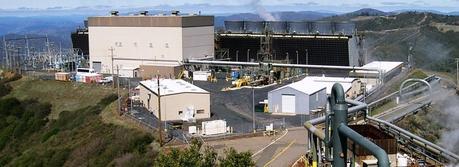
The Sonoma Calpine 3 geothermal power plant at The Geysers field in the Mayacamas Mountains of Somona County California, USA. Photographed looking northwest from the nearby helipad.
Since March 2012 geothermal generating capacity in the United States has grown by 145.05 MW, or 5%. Currently, geothermal energy makes up for more than 3% of total U.S. utility-scale electricity generation—that is significantly more than the share of solar (photovoltaic) energy.
Geothermal power plants are currently in operation in eight states, and in six other states geothermal projects are being developed. During the next decade more than 2,500 MW of new generation capacity should be added to the power grid.
According to the Geothermal energy association (GEA) “Geothermal Basics: Q&A” (September 2012), a total of 11,224 MW of geothermal energy was generated in 24 countries as of May 2012, with the United States being the leader of that list (3,187 MW).
So, what is the largest geothermal plant in the country that is the world leader in the field? The answer to that question is more complicated than you may think.
It is hard to judge which geothermal plants are the largest, because they a usually built in groups. For example, Wikipedia suggests that the largest geothermal plant in the United States is the Salton Sea Power Station (185 MW). However, according to the Geothermal Energy Association data, those are actually five different plants with total running capacity of 148 MW and total installed capacity of 170 MW. MidAmerican Renewables LLC (a company that owns the Salton Sea Power Station) says on its website that the company’s total owned geothermal generation capacity is 174 MW.
Same goes for Calistoga Power Plant (owned by the Calpine Corporation) that generates 66 MW of electricity (as stated both on the official site and by GEA—only the Wikipedia thinks that the plant somehow has the capacity of 176 MW).
Based on the GEA data, three largest geothermal power plants in the U.S. are BLM, NAVY I and NAVY II, all owned by Coso Operating Co. and located in California.
Plant
Owner
Running capacity (MW)
NAVY II
Coso Operating Co.
102
NAVY I
Coso Operating Co.
100
BLM
Coso Operating Co.
100
As can be seen, all this data is very much subject to a point of view. It is very easy, however, to point out the largest dry steam field in the world, which is the Geysers, located in 72 miles north of San Francisco. A geothermal plant complex there consists of 22 plants that draw power from more than 350 separate wells for a total capacity of 1, 517 MW. To compare, Hellisheiði Power Station, the largest power station in Iceland, has the capacity of 303 MW electricity and 133 MW thermal energy.

